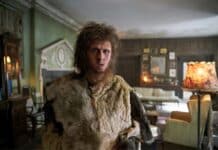The BBC’s Sherlock last episode, The Final Problem, was a love letter to the horror genre, says BRONTË SCHILTZ

In 2016, ahead of the release of the fourth series of Sherlock, creators Mark Gatiss and Steven Moffat sowed the seeds of anticipation. “Ghosts of the past are rising in the lives of Sherlock Holmes and John Watson bringing adventure, romance and terror in their wake,” they said. “This is the story we’ve been telling from the beginning. A story about to reach its climax…”
The first three series met with rave critical and popular responses, boasting Rotten Tomatoes scores between 91 and 94%. The fourth series, however, scraped 54%, continuing the downward trend set by 2016 Christmas special The Abominable Bride, which received 62%, pleasing some but leaving others seasonably cold.
Much of the disenchantment surrounding the fourth series centred on its increasingly outlandish plots, which many viewers felt sailed too far from the quasi-realism of the previous series. Scratch a little below the surface, however, and an alternative perspective begins to emerge – one with horror at its heart.
The Final Problem, a love letter to horror genre
The series’ final episode, The Final Problem, reads as a love letter to the horror genre. In the first scene post opening credits Mycroft watches a noir film that cuts into other footage, then the film corrodes (Sinister).
As he emerges, his hallway lights turn off (Nigel Kneale’s The Woman in Black). A girl in a blue dress awaits him (The Shining). A helmet falls from a suit of armour (The Castle of Otranto, the first Gothic novel). A clown appears (It). A figure moves past the window (The Innocents). The “girl” turns out to be an adult with dwarfism (Don’t Look Now).
Later, Sherlock, John and Mycroft sail to a psychiatric hospital on a secluded island (Shutter Island) described by a staff member as “Silence of the Lambs, basically.”
There, like Moriarty before her, the Holmes’ estranged sister, Eurus, appears on television screens (A Nightmare on Elm Street 3: Dream Warriors) to force them to participate in brutal “games” (Saw). In one, another prisoner’s wife is tied to a chair outside a window (Scream).
John discovers human bones at the bottom of a well (Ringu). In childhood, Eurus set fire to the family home (Firestarter).
This is by no means an exhaustive list: the episode is a veritable compendium of horror references. So what are they doing there?
Miranda Dawn persuasively argues that the fourth series does not exist in the programme’s previous reality but, rather, in the dreamscape established in The Abominable Bride, John’s blog entries seeping into Sherlock’s unconscious state.
This explains much of the episode’s supposed plot holes, such as John being chained to the bottom of the well in one scene, then lifted from it from above in another.
That this was intentional is surely more likely than the multi-award-winning writers, a script supervisor, BAFTA-winning production designer Arwel Wyn Jones and an editorial team of 12 missing a glaring continuity error.
“Of course it doesn’t make sense,” dream-Moriarty says when Sherlock identifies a plot hole of his own in The Abominable Bride. “It’s not real.”
Notably, several of the films referenced in The Final Problem concern dreams and the inability to distinguish reality from fantasy, especially Shutter Island, Dream Warriors and The Innocents, based on Henry James’ The Turn of the Screw. Kôji Suzuki’s Ring, the source material for Ringu and American remake The Ring, also features 37 references to dreams.
Moffat always intended for Sherlock to cover five series, arguably influenced by Thom Yorke’s five act structure. Crucially, Yorke lists reawakening as an overarching theme of the fifth act.
A fifth series would perhaps see Sherlock truly awaken with crucial knowledge (Mary Morstan villain arc, anyone?) informed by his metafictional descent into horror. After all, how else would Sherlock – his life one of “pure reason toppled by sheer melodrama” – process a crisis (a key theme of Yorke’s fourth act)?
“Is this silly enough for you yet?” dream-Moriarty asks Sherlock just before he ostensibly awakens in The Abominable Bride. “Gothic enough, mad enough, even for you?”
The fourth series was, it seems, too silly, Gothic and mad for the majority of viewers – but what a story Moffat and Gatiss could tell given the opportunity to carry it beyond its horrific climax to a proper conclusion.
What do you think about this article? Tell us about it in the comments section below!
BRONTË SCHILTZ is a journalist, writer and academic based in Manchester. She is on Twitter at @BronteSchiltz and her work can be found at bronteschiltz.squarespace.com.
Watch Arthur Conan Doyle’s Southsea Stories and Beyond Interview
READ: Gothic Horror and British Identity by Howard Jackson









